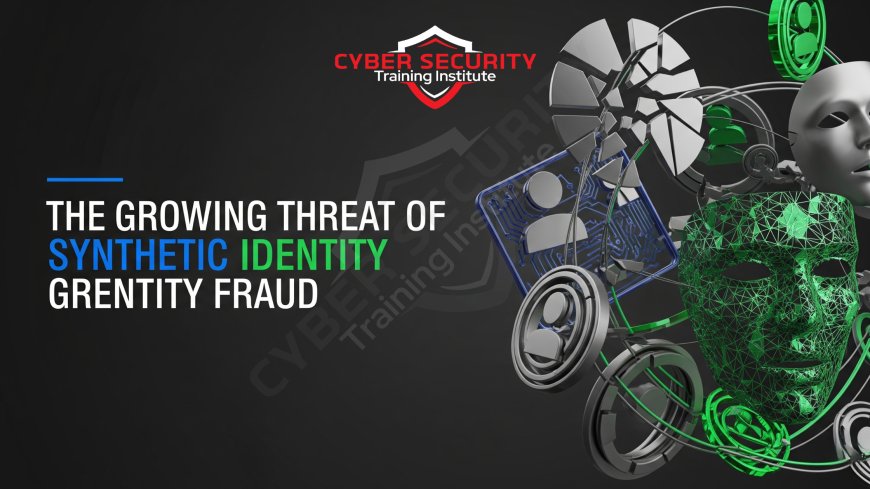The Growing Threat of Synthetic Identity Fraud
A new and insidious form of financial crime is on the rise: synthetic identity fraud. This in-depth article, written from the perspective of today's threat landscape, explains how criminals are creating "digital ghosts" by combining real, stolen ID numbers with completely fake personal details and AI-generated faces. We break down the patient, "long con" playbook of "bust-out" fraud, where these synthetic identities are used to build up a legitimate-looking credit history over months or years before maxing out all available credit and disappearing, leaving financial institutions with massive, unrecoverable losses. Discover why this threat is so dangerous and why traditional fraud detection systems are often blind to it. The piece features a comparative analysis that clearly distinguishes the methods and victims of traditional identity theft versus this new, synthetic fraud. We also explore the critical role that AI is now playing on both sides of this battle—with criminals using AI to create and manage their synthetic armies, and financial institutions using their own AI to detect the faint, statistical signals of these non-existent customers. This is an essential read for anyone in the finance, credit, or cybersecurity industries who needs to understand one of the most sophisticated and rapidly growing forms of financial crime.

Introduction: The Ghost in the Machine
What if the most dangerous identity thief isn't trying to steal your identity, but is instead creating a brand new, completely fake one from scratch? This is the bizarre and rapidly growing threat of synthetic identity fraud. It's a new breed of financial crime that isn't about impersonating a real, living person; it's about giving birth to a digital ghost and then using that ghost to steal millions. This threat has been supercharged by the power of Artificial Intelligence, which makes creating these "synthetics" easier and more believable than ever. Synthetic identity fraud is a growing threat because these AI-assisted, non-existent identities are incredibly difficult for traditional fraud detection systems to spot, can be used to patiently build legitimate-looking credit histories, and serve as the perfect, untraceable tool for a wide range of large-scale financial crimes.
What Is a Synthetic Identity?
A synthetic identity is a fraudster's version of Frankenstein's monster. It's a fake identity that is carefully stitched together from a combination of real and fabricated information to create a persona that looks legitimate to a computer.
The typical formula is:
- A Real, Stolen ID Number: The fraudster starts with a real, valid government ID number, like a Social Security Number in the US or a similar national identifier. Crucially, they steal this number from a person who is not likely to be actively using the credit system, such as a young child, a senior citizen, or even a recently deceased person. This is the "real" part of the identity that makes it seem legitimate.
- Completely Fabricated Personal Details: The fraudster then attaches this real ID number to a completely fake name, date of birth, and physical address.
- An AI-Generated Face: To pass modern identity verification checks, the fraudster will often use Generative AI to create a unique, photo-realistic "face" for their synthetic person. This synthetic face can then be used for profile pictures or to create a fake ID document.
The result is an identity that passes many automated checks. It has a real ID number, so it doesn't get flagged as fake, but it doesn't belong to any single, real person who might notice the fraudulent activity and report it. It is, for all intents and purposes, a ghost in the financial system.
The Long Con: How "Bust-Out" Fraud Works
Synthetic identity fraud is not a quick smash-and-grab. It is a patient, long-term con that can take months or even years to execute. The most common form of this fraud is known as a "bust-out."
- Step 1: Establishing a Foothold. The fraudster uses their newly created synthetic identity to apply for simple, low-risk forms of credit. This could be a store credit card, a small personal loan from an online lender, or by being added as an authorized user on another account. Because the ID number is real, the synthetic identity often passes the initial, automated credit check and gets approved.
- Step 2: Building a Legitimate Credit History. For the next several months, or even a couple of years, the fraudster acts like the perfect customer for their synthetic identity. They use the credit, and they make all of their payments on time, every single time. This slowly and patiently builds a legitimate-looking, positive credit history and a strong credit score for the fake identity.
- Step 3: The "Bust-Out." This is the final stage of the con. Once the synthetic identity has built up a strong credit history and a high credit score, the fraudster can then apply for and receive much larger, premium lines of credit—multiple high-limit credit cards, car loans, and large personal loans. In a coordinated final move, they max out every single one of these accounts in a very short period and then completely disappear.
The banks and lenders are left with a massive loss. When they try to find the "person" who has defaulted on all these loans, they discover that the name, the address, and the face were all fake. There is no real person to pursue. The money is simply gone. .
Why Traditional Fraud Detection Fails
This type of fraud is so effective because it is specifically designed to bypass the traditional methods that banks and lenders use to detect fraud.
- There Is No Victim to Report the Crime: In a traditional identity theft case, the real victim will eventually get an alert or a bill in the mail for an account they didn't open. They will then report the fraud, and the account is shut down. With a synthetic identity, there is no single, real victim to notice the fraudulent activity. The owner of the stolen ID number is often a child who won't be checking their credit report for many years. The lack of a victim report allows the fraud to continue undetected for a very long time.
- It Passes Automated Checks: The identity passes many of the initial, automated verification checks because it is built around a real, valid government ID number that has not been flagged for fraud.
- It Behaves Legitimately: For most of its "life," the synthetic identity acts like a perfect, low-risk customer. It pays its bills on time. This means it doesn't trigger the behavioral alarms in a bank's fraud detection system that are designed to look for classic, erratic fraud patterns.
Comparative Analysis: Traditional Identity Theft vs. Synthetic Identity Fraud
While both are forms of identity fraud, the methods, the victims, and the detection techniques are completely different.
| Aspect | Traditional Identity Theft | Synthetic Identity Fraud |
|---|---|---|
| The Identity Used | An attacker impersonates a single, real victim, using their real name, address, date of birth, and ID number. | An attacker fabricates a new, composite identity by combining a real, stolen ID number with a completely fake name and other personal details. |
| The Primary Victim | The individual person whose identity is stolen. They have to deal with the ruined credit and the hassle of clearing their name. | The financial institutions and lenders who extend credit to a non-existent person and are left with a massive, unrecoverable loss. |
| Detection Method | Is often detected relatively quickly when the real victim reports the fraudulent activity that they see on their legitimate accounts or credit reports. | Is extremely difficult to detect in its early stages, as there is no single, real victim to report the crime. It is often only discovered after the "bust-out." |
| Criminal's Tactic | Is typically a "smash-and-grab" attack. The goal is to use the stolen identity to max out credit and get cash as quickly as possible. | Is a patient, "long con." The goal is to slowly and patiently build a legitimate-looking credit history over a long period before the final, large-scale "bust-out." |
The Role of AI in Creation and Defense
The battle over synthetic identity fraud has become a true AI-vs-AI arms race. Just as criminals are using AI to make their attacks more effective, defenders are using AI to get better at spotting these digital ghosts.
- AI for the Offense: Criminals are using Generative AI to create the highly realistic synthetic faces and fake ID documents that are needed to pass modern, video-based KYC checks. They are also using automation and AI to manage thousands of these synthetic identities at once, automating the process of applying for credit and making small, regular payments to build their credit histories at an industrial scale.
- AI for the Defense: In response, financial institutions are now deploying their own, more sophisticated AI models that are specifically trained to spot the subtle, tell-tale signs of a synthetic identity. A defensive AI can look for patterns that a human or a simple rule-based system would miss. For example, it can flag an application as suspicious if it sees that the ID number has been on file for years but has never been associated with any other "real world" data, like a utility bill or a phone record. It can also use advanced network analysis to see if hundreds of seemingly unrelated accounts are all being accessed from the same few devices, revealing the "puppet master" behind the synthetic identities.
Conclusion: Fighting the Digital Ghosts
Synthetic identity fraud is a sophisticated, patient, and highly profitable crime that is perfectly designed to exploit the gaps in our modern, automated credit-checking systems. The threat is so dangerous because it has no obvious victim in its early stages, and because it is designed to look like a legitimate, low-risk customer to many traditional fraud models. As criminals continue to use AI to make their synthetic identities more believable and to manage them at a greater scale, the problem is only going to grow.
The only way to effectively fight this new, AI-powered form of fraud is with an even smarter defensive AI. The battle is moving from simple identity verification to a deeper, more analytical level. Financial institutions must now use their own machine learning models to find the faint, almost invisible statistical patterns and behavioral anomalies that betray the existence of a digital ghost in their systems.
Frequently Asked Questions
What is a synthetic identity?
A synthetic identity is a fake identity that is created by a fraudster by combining a real, stolen government ID number (like a Social Security Number or Aadhaar number) with completely fabricated personal details, such as a fake name and date of birth.
How is a synthetic identity made?
It is made by stitching together real and fake information. The real part is the stolen ID number, and the fake parts are the name, address, and often an AI-generated profile picture.
What is a "bust-out" fraud?
A "bust-out" is the final stage of a synthetic identity fraud scheme. After patiently building a good credit history for the fake identity for months or years, the fraudster maxes out all the available credit at once and then disappears, leaving the lenders with a massive loss.
Why are children's ID numbers often used for this?
Because children do not have any existing credit history, and they are not likely to check their own credit reports for many years. This gives the fraudster a long, clear runway to build a credit history for the synthetic identity without being discovered.
Can AI really create a fake face?
Yes. Modern Generative AI, specifically a technology called a Generative Adversarial Network (GAN), can create completely unique, photo-realistic images of people who do not exist. These are used for fake profile pictures and ID documents.
What is KYC?
KYC stands for "Know Your Customer." It is the mandatory process of identity verification that financial institutions must perform when a new customer opens an account. Criminals use synthetic identities and deepfakes to try and bypass these checks.
How do banks and lenders defend against this?
They are now using their own advanced AI and machine learning models to look for the subtle, statistical red flags of a synthetic identity. For example, they can check if a single physical address is being used on hundreds of different credit applications.
Is my own identity at risk from this?
Your identity is not at risk of being "stolen" in the same way as traditional identity theft, as the fraudster is not impersonating you. However, if your or your child's government ID number is stolen and used as the base for a synthetic identity, it can cause major problems for you years later when you try to apply for legitimate credit.
What is a "credit bureau"?
A credit bureau is a company that collects and maintains credit information on consumers and provides that information to lenders. Fraudsters build a credit history for their synthetic identities within these bureau systems.
Why is this called a "long con"?
Because, unlike a quick smash-and-grab attack, this type of fraud requires the criminal to be very patient, often spending a year or more making small, regular payments to build up the synthetic identity's credit score before the final "bust-out."
What is a "money mule"?
A money mule is a person or an account that is used to help launder money. Synthetic identities are often used to create bank accounts that can then be used as money mules.
Is this a victimless crime?
No. While there isn't a single, obvious individual victim in the same way as traditional identity theft, the financial institutions are the primary victims, and these massive losses are ultimately passed on to all consumers in the form of higher prices and fees.
What is a Generative Adversarial Network (GAN)?
A GAN is the type of AI that is used to create synthetic faces. It works by having two competing neural networks—a "generator" that creates the fakes and a "discriminator" that tries to spot them—which forces the generator to become incredibly realistic.
How does this fraud start?
It almost always starts with the theft of a real government ID number from a data breach. Protecting this number is a key step in preventing the creation of a synthetic identity.
How is this different from a deepfake?
A deepfake is a fake video or audio clip of a *real* person. A synthetic identity uses an AI-generated image of a *fake* person who does not exist. A deepfake of the synthetic identity can then be used to pass a video liveness check.
What is a "credit score"?
A credit score is a number that represents the creditworthiness of a person. Fraudsters patiently build a high credit score for their synthetic identities to make them seem like trustworthy borrowers.
Can this be used for things other than financial fraud?
Yes. Synthetic identities can be used to create armies of fake but realistic-looking social media accounts for the purpose of spreading disinformation or manipulating public opinion.
Why don't traditional fraud models catch this?
Because traditional models are trained to look for the known patterns of past fraud. Synthetic identities are designed to look and act like perfect, low-risk customers, so they don't trigger these old alarms.
How can I protect my child's ID number?
Be very careful about where you share your child's sensitive personal information. If it is an option in your country, you can proactively place a freeze on your child's credit file, which will prevent any new accounts from being opened with their information.
What is the biggest challenge in fighting this threat?
The biggest challenge is that there is no single, real victim to report the crime in its early stages. The fraud is allowed to grow and fester for a long time, and is often only discovered after the criminals have already made off with the money.
What's Your Reaction?
 Like
0
Like
0
 Dislike
0
Dislike
0
 Love
0
Love
0
 Funny
0
Funny
0
 Angry
0
Angry
0
 Sad
0
Sad
0
 Wow
0
Wow
0







![How to Install RHEL 10 on VMware/VirtualBox [Tutorial]](https://www.cybersecurityinstitute.in/blog/uploads/images/202509/image_430x256_68b56dc967a4a.jpg)







